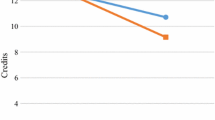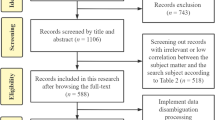Abstract
In this study, we investigate the downloads behavior of readers for two well-known IEEE journals in the field of education, i.e., IEEE Transactions on Learning Technologies (TLT) and IEEE Transactions on Education (ToE). In our analysis, we found that articles in both journals are not downloaded rapidly in earlier months. The majority of articles reach to 50 and 80% of their first 12 months downloads’ total in later months. Using linear regression analysis, we discovered that the cumulative first 12 months downloads of articles cannot be predicted by earlier months downloads. However, it can be predicted more accurately by using cumulative downloads count of later months. Moreover, we found that average downloads of articles in both journals increases rapidly as soon as they are assigned to an issue. In case of TLT which follows a delayed open access policy, we observed that average downloads after open access increases marginally for 2 months, and then it declines and continues to progress more or less in a consistent manner for 2 years. While in ToE which does not follow such policy, the average downloads decreases persistently.










Similar content being viewed by others
References
Bollen, J., Luce, R., Vermulapalli, S. S., & Xu, W. (2003). Usage analysis for the identification of research trends in digital libraries. D-Lib Magazine, 9(5).
Bollen, J., Sompel, H. V., Smith, J. A., & Luce, R. (2005). Toward alternative metrics of journal impact: A comparison of download and citation data. Information Processing and Management, 41(6), 1419–1440.
Bornmann, L., & Daniel, H. (2008). What do citation counts measure? A review of studies on citing behavior. Journal of Documentation, 64(1), 45–80.
Brank, J., & Leskovec, J. (2003). The download estimation task on KDD Cup 2003. ACM SIGKDD Explorations Newsletter, 5, 160–162.
Brody, T., Harnad, S., & Carr, L. (2006). Earlier web usage statistics as predictors of later citation impact. Journal of the American Society for Information Science and Technology, 57(8), 1060–1072.
Chu, H., & Krichel, T. (2007). Downloads vs. citations: Relationships, contributing factors and beyond. In: Proceedings of the 11th international society for scientometrics and informetrics conference (pp. 207–215). Madrid, Spain.
De Sordi, J. O., Conejero, M. A., & Meireles, M. (2016). Bibliometric indicators in the context of regional repositories: proposing the D-index. Scientometrics, 107(1), 235–258.
Gorraiz, J., Gumpenberger, C., Jack, K., Kraker, P., & Schlögl, C. (2013). What do citations, downloads and readership data of an information systems journal have in common and where do they differ? In: Translational twists and turns: Science as a socio-economic endeavor, Proceedings of 18th international conference of science and technology indicators (STI 2013). (pp. 140–145).
Gorraiz, J., Gumpenberger, C., & Schlögl, C. (2014). Usage versus citation behaviours in four subject areas. Scientometrics, 101(2), 1077–1095.
Harnad, S., & Brody, T. (2004). Comparing the impact of open access (OA). vs. non-OA articles in the same journals. D-Lib Magazine, 10(6).
Huntington, P., Nicholas, D., Jamali, H. R., & Tenopir, C. (2006). Article decay in the digital environment: An analysis of usage of OhioLINK by date of publication, employing deep log methods. Journal of the American Society for Information Science and Technology, 57(13), 1840–1851.
IEEE. (2016a). http://ieeexplore.ieee.org/Xplorehelp/#/about-ieee-xplore/about-content.
IEEE. (2016b). http://ieeexplore.ieee.org/Xplorehelp/#/personalization-settings/content-alerts.
Jamali, H. R., Nicholas, D., & Huntington, P. (2005). The use and users of scholarly e-journals: A review of log analysis studies. Aslib Proceedings, 57(6), 554–571.
Jamali, H. R., & Nikzad, M. (2011). Article title type and its relation with the number of downloads and citations. Scientometrics, 88(2), 653–661.
Khan, M. S. (2011). Aspects of content quality management in digital libraries of scholarly communications (Unpublished doctoral dissertation). Graz University of Technology.
Kurtz, M. J., Eichhorn, G., Accomazzi, A., Grant, C., Demleitner, M., Murray, S. S., et al. (2005). The bibliometric properties of article readership information. Journal of the American Society for Information Science and Technology, 56(2), 111–128.
Maurer, H. (2012). A linear ordering of a multi-parameter universe is usually nonsense. Theoretical Computer Science, 429, 222–226.
Moed, H. F. (2005). Statistical relationships between downloads and citations at the level of individual documents within a single journal. Journal of American Society for Information Science and Technology, 56(10), 1088–1097.
Nature. (2012). http://www.nature.com/news/announcement-a-new-ipad-app-for-nature-readers-1.12002.
Nature. (2016). https://www.natureasia.com/en/advertising/PDF/MediaKit.pdf.
O’Leary, D. E. (2008). The relationship between citations and number of downloads in decision support systems. Decision Support Systems, 45(4), 972–980.
Rowlands, I., & Nicholas, D. (2007). The missing link: Journal usage metrics. Aslib Proceedings, 59(3), 222–228.
Schlögl, C., Gorraiz, J., Gumpenberger, C., Jack, K., & Kraker, P. (2014). Comparison of downloads, citations, and readership data for two information systems journals. Scientometrics, 101(2), 1113–1128.
Shepherd, P. T. (2007). The feasibility of developing and implementing journal usage factors: A research project sponsored by UKSG. Serials, 20(2), 117–123.
TLT. (2016a). http://ieeexplore.ieee.org/xpl/aboutJournal.jsp?punumber=4620076.
TLT. (2016b). http://ieeexplore.ieee.org/xpl/tocresult.jsp?isnumber=4620077.
ToE. (2016a). http://ieeexplore.ieee.org/xpl/aboutJournal.jsp?punumber=13.
ToE. (2016b). http://ieeexplore.ieee.org/xpl/tocresult.jsp?isnumber=4358717.
Wan, J., Hua, P., Rousseau, R., & Sun, X. (2010). The journal download immediacy index (DII): Experiences using a Chinese full-text database. Scientometrics, 82(3), 555–566.
Wang, X., Liu, C., Mao, W., & Fang, Z. (2015). The open access advantage considering citation, article usage and social media attention. Scientometrics, 103(2), 555–564.
Wang, X., Mao, W., Xu, S., & Zhang, C. (2014a). Usage history of scientific literature: Nature metrics and metrics of Nature publications. Scientometrics, 98(3), 1923–1933.
Wang, X., Wang, Z., Mao, W., & Liu, C. (2014b). How far does scientific community look back? Journal of Informetrics, 8(3), 562–568.
Wang, X., Wang, Z., & Xu, S. (2013). Tracing scientist research trends realtimely. Scientometrics, 95(2), 717–729.
Wang, X., Xu, S., Peng, L., Wang, Z., Wang, C., Zhang, C., et al. (2012). Exploring scientists working timetable: Do scientists often work overtime? Journal of Informetrics, 6(4), 655–660.
Author information
Authors and Affiliations
Corresponding author
Additional information
Muhammad Younas completed this work during his studies at COMSATS Institute of Information Technology, Lahore, Pakistan.
Rights and permissions
About this article
Cite this article
Khan, M.S., Younas, M. Analyzing readers behavior in downloading articles from IEEE digital library: a study of two selected journals in the field of education. Scientometrics 110, 1523–1537 (2017). https://doi.org/10.1007/s11192-016-2232-7
Received:
Published:
Issue Date:
DOI: https://doi.org/10.1007/s11192-016-2232-7




